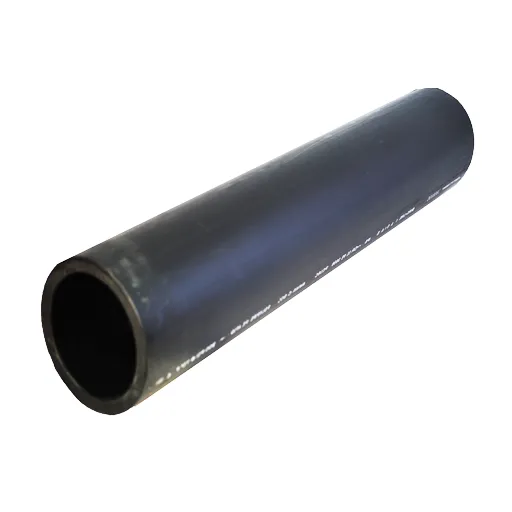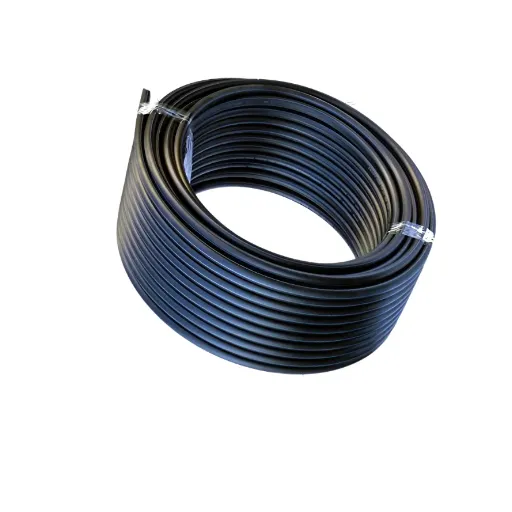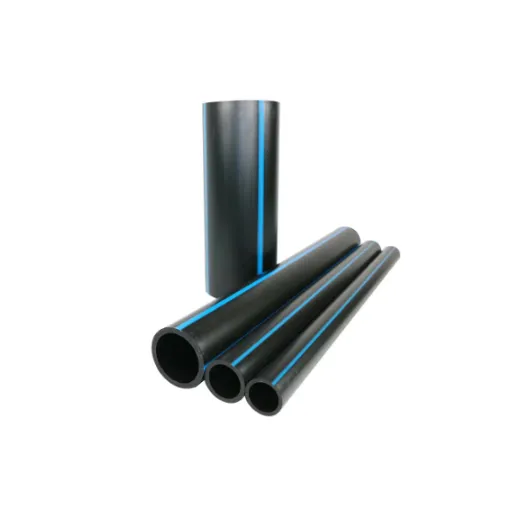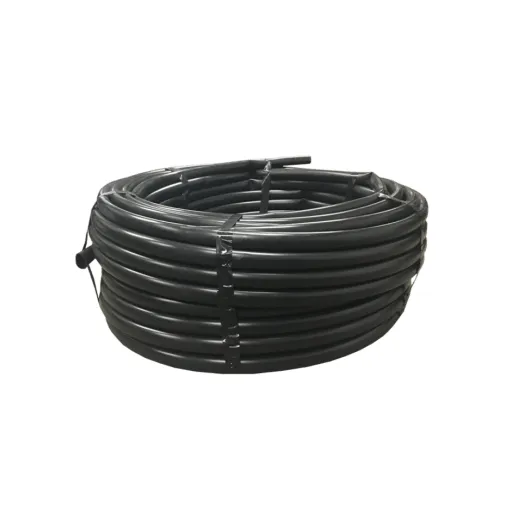The HDPE pipes have created an amazing opportunity in the piping system by offering the highest ability in durability, flexibility, and reliability. SDR-11 HDPE pipe becomes a component of great consideration in commercial and industrial applications because of being robust performance. But what really differentiates SDR-11 HDPE pipes, and why are they accepted in many projects? This article discusses SDR-11 HDPE pipes from the basic features through practical use and advantages, so that one could conceptualize why they have become vital in modern infrastructure. The guide shall shed some light on advances in piping technology for the field professional, and, of course, for the curious reader, so that together, we may at least look at the reasons justifying the present craze for SDR-11 HDPE pipes.
What is SDR-11 HDPE Pipe?

Definition and Composition
SDR-11 HDPE piping refers to High-Density Polyethylene (HDPE) piping with a Standard Dimension Ratio (SDR) of 11. The SDR refers to the relationship between the pipe wall thickness and the pipe diameter, so an SDR-11 pipe has a wall thickness equal to 1/11th of the pipe’s outside diameter. This geometry maintains a proper balance between strength and flexibility required for numerous demanding applications.
The constitution of the SDR-11 HDPE pipe is mainly that of a high-density polyethylene rigid, lightweight, and corrosion-resistant polymer. The material is non-toxic and eco-friendly, having the capacity to endure enough stress and pressure when placed in industrial and municipal piping systems. The HDPE also contains a certain amount of additives to improve resistance to UV rays and chemicals, and also against cracking to extend pipe service life during its application in difficult scenarios.
Due to its thick walls, this pipe can provide maximum pressure resistance and hence is mainly used for water distribution, natural gas transmission, and industrial fluid handling. Moreover, the smooth interior surface of SDR-11 HDPE pipes further reduces readily friction and buildup of material on the pipe wall, allowing the fluid to flow efficiently. On account of its high performance and versatility, SDR-11 HDPE is a popular and trusted choice for modern infrastructure projects.
Understanding SDR and Its Significance
SDR, meaning Standard Dimension Ratio, is a term that provides the relationship between a pipe’s outside diameter and its thickness. This means that it is calculated by dividing the pipe diameter by the thickness of its walls. The lesser the SDR, the thicker the pipe walls, which means greater pressure resistance and durability. Hence, the significance of SDR when it comes to the application or performance of pipes in various systems.
The point of SDR is to provide a standardized way of evaluating the strength of the pipe and its suitability in specific applications. For example, SDR-11 HDPE pipes are particularly strong and, therefore, suitable for high-pressure applications such as gas and water distribution. Understanding SDR helps engineers and project planners pick the right pipes for their applications with specific safety and performance requirements.
Choosing the right SDR becomes instrumental in assuring long-term reliability and efficiency in infrastructure projects. Pipes that have been adequately rated with the required SDR are least likely to fail, thus requiring less maintenance and guaranteeing consistent performance. Hence, understanding the SDR is not only incorporated in the technical design level but also has very critical implications in sustaining and actualizing various construction and industrial projects.
Pressure Ratings: 150 psi vs. 200 psi
The 150 psi and 200 psi pressure ratings stand as designations that may be chosen based on the exact needs of an individual application. Pressure ratings specify the maximum pressure that a pipe or system will safely accommodate under operating conditions. For a system with a higher fluid or gas pressure, a 200 psi-rated pipe should again withstand greater pressure, hence fewer leaks or failures. On the contrary, a 150 psi-rated pipe would suffice under moderate-pressure-demand situations and would thus provide a cheaper alternative when reliable.
Undergoing physical stress and pressures, 200 psi pipes are application-wise popular for drainage systems involving very-high-pressure water, industrial fluids, and specific fire protection systems. This higher rating ensures that under fluctuating or peak pressure conditions, the pipe does not rupture, causing productivity losses and possible safety issues.
150 psi pipes find their application in water service distribution to the homeowner, and in other low-pressure applications. Generally, these pipes are relatively less expensive, easy to install, and thus fit with an environment that does not warrant heavy pressure resistance. Hence, the right choice will depend exactly on the working conditions, safety considerations, and cost.
Applications of SDR-11 HDPE Pipe

Construction Industry Uses
Due to all of their features relating to durability, flexibility, and resistance to corrosion, SDR-11 HDPE pipes have been serving the construction industry. The following applications are some of the major uses of SDR-11 HDPE pipes in construction:
- Water Supply: The pipes in question are employed in the distribution of potable water to residential and commercial buildings, among others. They have excellent strength and leak-resisting qualities, which ensure that water distribution will last for many years.
- Sewage and Drainage Systems: The pipes constitute a part of the sewage and drainage systems, carrying away wastewater, while providing some measure against the occurrence of blockages or leaks.
- Underground Cable Protection: SDR 11 HDPE pipes provide superior protection and are used as conduits to protect cables for electrical and communication installations against ingress of water, physical injury, and environmental hazards.
- Geothermal Piping: Marking its thermal properties as excellent, these pipes are used extensively in geothermal systems to transfer heat or coolant from the earth’s surface to heating systems inside buildings.
- Irrigation Systems: SDR-11 HDPE pipes are an essential part of building efficient irrigation systems for agricultural projects. They are built to provide constant and reliable water flow and are resistant to chemical fertilizers and pesticides.
Launching into a number of uses emphasizes the versatility and reliability of SDR-11 HDPE pipes.
Agricultural Applications
SDR-11 HDPE pipes find many agricultural applications due to the ruggedness, flexibility, and adverse weather resistance of these pipes. They serve as an improvement in the utilization of water and in the design of efficient delivery systems. Here are five major agricultural applications of SDR-11 HDPE pipes:
- Irrigation: SDR-11 HDPE pipes in drip and sprinkler irrigation systems provide steady flow rates, thus minimizing wastage of water and ensuring that crops remain optimally hydrated.
- Fertilizer distribution: These pipes resist chemical corrosion and are suitable for distributing liquid fertilizers to crops, causing little or no damage or contamination.
- Drainage systems: Farmers use SDR-11 HDPE pipes to set up efficient drainage systems that prevent waterlogging in the fields and protect crop roots from diseases caused by excess moisture.
- Aquaculture: HDPE pipes are important in fish farming and aquaculture systems; they carry fresh water and waste through harsh water conditions.
- Greenhouse Irrigation: Being thermally stable and flexible, SDR-11 HDPE pipes find their use in automated irrigation in greenhouses for efficient water distribution in controlled environments.
The application described above gives emphasis to the crucial role SDR-11 HDPE pipes play in facilitating a sustainable and efficient agricultural practice.
Water Distribution Systems
Water supply systems are important for ensuring a reliable and efficient water supply to all sectors. SDR-11 HDPE pipes are vital to ensure the performance and life of these systems. Mentioned below are the five main types of water-distribution systems where SDR-11 HDPE pipes find use:
- Municipal Water Supply Networks: SDR-11 HDPE pipes are employed for delivering potable water to towns and rural areas. Corrosion resistance ensures a long working life for these pipes, making them the least expensive alternatives.
- Industrial Water Supply Systems: They are used in industrial sectors for the transportation of process water, cooling water, and other non-potable water requirements. High pressure and chemical resistance make them quite appropriate for industrial purposes.
- Agricultural Water Distribution: Irrigation and water storage for farming: SDR-11 HDPE pipes provide uniform and adequate water application that would ultimately aid agricultural productivity.
- Fire Protection Systems: The SDR-11 HDPE pipes are used for the underground firewater networks, having pressure-resistance capabilities and quick installation in emergencies for fire safety.
- Desalination and Water Treatment Plants: SDR-11 HDPE pipes are utilized in these systems and plants to carry treated water, brine, or seawater because of their corrosion resistance and temperature tolerance.
Such applications emphasize the flexibility and importance of the SDR-11 HDPE pipes in present-day water distribution systems to the efficiency and reliability of these.
Advantages of SDR-11 HDPE Pipe

Durability and Longevity
The SDR 11 HDPE pipes have carved out a reputation for the utmost durability and long life. Some industries treat them as one among many product choices; however, water distribution systems demand reliability with the least maintenance. These pipes are produced using high-density polyethylene material, which tolerates cracking, abrasion, and impact very well. Under normal operating conditions, studies have demonstrated that SD-11 HDPE pipes tend to retain their integrity for more than 50 years, with very few replacements needed, hence saving huge infrastructure project costs over the long run.
The pipes have never been able to sustain the kind of forces that go into dissipating the energy of erosion of the embankments by the waves. Because operational strength of SDR-11 HDPE pipes, none of the processes of aggressive natural environmental conditions, including very heavy heat, freezing temperatures, or UV radiation, affects their performance. Plus, their resistance towards any corrosion enables the SDR-11 HDPE pipes to propose a solution for any situation where the pipe is subject to aggressive solutions such as saltwater or chemicals that normally would degrade metal pipes. Corrosion resistance, thus, extends their life in applications such as saltwater desalination and wastewater treatment.
Advanced engineering and design behind SDR-11 HDPE pipes allow the pipes to maintain their structural integrity against high-pressure conditions. Due to a thicker wall structure, SDR-11 pipes can take heavier pressure ratings as compared to the lighter SDR categories and can thus be put to stringent applications such as industrial pipelines, municipal water systems, or irrigation networks. By marrying these qualities with minimum maintenance, SDR-11 HDPE pipes stand as an unmatched value, making these pipes an investment that no modern infrastructure project can evade.
Flexibility and Ease of Installation
Flexibility is the most distinguishing characteristic of SDR-11 HDPE pipes. Unlike steel or PVC pipes that retain their rigidity against unusual applications of force, HDPE pipes, by design, can bend to accommodate the sloping terrains or difficult layouts involved in plumbing. The reduction in fittings required, primarily elbows and joints, cuts down considerably on the material and labour costs. They can also absorb ground movements, such as slight earthquakes and soil subsidence, within the very application framework itself, thereby ensuring long-term reliability irrespective of the kind of environment.
Installation ease is an added reason for the appeal of SDR-11 HDPE pipes in the construction and utility industries. Being very light in weight, these pipes are easy to handle, transport, and install even in remote locations where accessibility is a problem. Strong and leak-free joints can be formed using advanced joining techniques such as heat fusion, which also simplifies the installation process and guarantees a strong and durable network. Trenchless installation methods, such as horizontal directional drilling (HDD), render HDPE pipes especially appropriate for projects that intend to keep surface disruption to a bare minimum, e.g., urban infrastructure or environmentally sensitive areas.
In view of the long service life enjoyed by SDR-11 HDPE pipes, together with performance benefits, they allow minimal maintenance. These other luring qualities attract industries working for efficiency with a pinch of economy as well, such as resistance to corrosion, chemical treatment, and physical attrition. Through all these qualities of smooth deployment in the initial phase of installation and long-lasting resistance and durability, the SDR-11 HDPE pipe makes even further progress as a modern-day essential in infrastructure construction.
Corrosion Resistance Compared to PVC and Metal
Water and some chemicals prove to be corrosive for metals, forcing them to undergo some anti-corrosion treatments, whereas HDPE and PVC do not experience corrosion and hence are resistant to corrosion.
| Material | Corrosion | Durability | Maintenance | Cost | Applications |
|---|---|---|---|---|---|
| HDPE | High | Long-lasting | Low | Moderate | Underground, industrial |
| PVC | High | Long-lasting | Low | Low | Plumbing, drainage |
| Metal | Low | Moderate | High | High | High-pressure, high-temp |
Installation Guidelines for SDR-11 HDPE Pipe

Proper Handling Techniques
Transportation, storage, and installation of SDR-11 HDPE pipes mandate certain techniques for safe handling and long service life. During lifting and transportation of pipes, either non-abrasive slings or some padded supports should be used to avoid surface damage or deformation. Never rolling pipes down from vehicles or dropping them onto hard surfaces can cause cracks or points of stress in their structure.
Consider having the storage areas flat and devoid of any profile sharp objects worth stick out to puncture or abrade the pipes. While stacking pipes, all layers must be kept stable and in alignment so as not to create conditions for accidental shifts or collapse. Protect HDPE pipes during storage against prolonged direct sunlight by covering them with UV-resistant tarps. On installation, lay pipes into trenches carefully, avoiding sharp bends and excessive tension that could jeopardize their integrity.
Important: Strictly maintaining these practices ensures sustained high inherent strength and durability of the SDR-11 HDPE pipes with less chance of damage and, therefore, smooth running of the project.
Various Fusion Methods
When joining SDR-11 HDPE pipes, a number of fusion methods are at one’s disposal, each ideally suited to particular applications and requirements. The most commonly used are butt fusion, electrofusion, and socket fusion.
Butt Fusion
This is the most common way of joining HDPE pipes. The ends of the pipe are heated and then pressed together under controlled pressure to form a monolithic joint. This method is suitable for large diameter pipes since the joint produced is strong and uniform, and can withstand high-pressure demands. Proper calibration of the equipment and training of the operator are the two most critical factors in ensuring a good weld.
Electrofusion
This technique employs special fittings with electrical heating elements embedded in them. Upon the current flow, those heating elements melt the material, and the pipe and the fitting are fused. Due to its precision and versatility, electrofusion is often preferred in tight spots or for repair work. It is particularly suitable for joining pipes in areas where traditional butt welding equipment may have limited access.
Socket Fusion
Usually, for smaller-diameter pipes, this method involves heating the pipe end and the fitting at the same time and then joining them together. Socket Fusion is much simpler and requires fewer specialized equipment, making it an ideal method for applications that require fast and efficient joining.
Professional Tip: As long as the welding procedure is adhered to, these fusion methods guarantee that the connection will be long-lasting and leakproof. Quality of connection can be enhanced and potential installation errors eliminated by employing more advanced technology, such as an automatic welding machine and real-time monitoring systems. Taking the right fusion process for your project will give the best performance and longest life to an SDR-11 HPDE piping system.
Key Considerations for Secure Setup
The installation phase for SDR-11 HDPE piping systems demands attention to several key factors to achieve a secure and efficient installation. First of all, make sure to conduct a thorough inspection of all materials and components before installation to ensure that they conform to the required specifications and are free from defects. Another consideration is the proper storage and handling of pipes because any warping or damage may affect system integrity.
The procedures should be adhered to very strictly in welding. Ensure welders or operators have been properly trained and are certified in HDPE welding techniques so lousy welds are less likely to occur. Use technologies like automatic welding machines and real-time monitoring systems to enhance the accuracy of welds; this will reduce human error and improve the overall performance of a system.
Lastly, environmental factors such as temperature and humidity should be deemed relevant as they are known to affect welding and fusing processes. Quality control mechanisms must be checked during and after installation, which may include pressure testing and visual scrutiny to ascertain that the system is firmly installed and ready for long-term operation. This consideration will further maximize the efficiency and reliability of your SDR-11 HDPE piping project.
Recent Trends and Innovations in HDPE Pipe Usage
Growing Market Demand for Sustainable Solutions
The increasing sustainability emphasis across all industries worldwide has significantly created a vigorous demand for environmentally friendly materials like HDPE pipes. These pipes were known to be more durable, more recyclable than metal or concrete, and generally considered to have a lesser environmental impact. Since turning into an issue of global concern, anything to do with combating climate change and conserving resources is governments’ and organizations’ top priority at present; hence ordering all distribution of gas, wastewater treatment, or water management systems through an HDPE piping system. Their choice aligns with wider efforts to curb greenhouse gas emissions and promote circular economies.
Increasing attention on green infrastructure has fueled market expansion for HDPE pipes, which are known for their longevity and corrosion resistance. The pipes work in any number of applications with the additional advantages of being architecturally beneficial, such as decreased energy during manufacture and ease in recycling upon completion of end use. There have been industries that have started to prefer HDPE pipes as they are supportive of LEED certifications as well as other sustainability programs, making them more attractive.
Another driver fueling this demand is the rapid urbanization and population growth in both developed and developing nations. Cities and towns are increasingly pressed to upgrade existing water systems and put forth the infrastructure necessary to support these new areas. With all policies and directives emphasizing green solutions, HDPE pipes would be the perfect option due to the cost advantage and sustainability aspects. On the other side, innovations in HDPE pipe manufacturing technologies, like those of multilayer technology and smart piping systems, keep on building their reputation as the perfect sustainable solution in a changing market.
Advancements in Manufacturing Processes
I think innovation and efficiency are important factors when talking about manufacturing methods. I have seen over time how multilayer technology and automation have benefited in making HDPE pipes. In this way, multilayer technology has helped multilayer pipes to be designed for more strength, durability, and functionality. These improvements comply with high standards of performance today, whereas they are quite close to the aspects of sustainability that are increasingly recognized in present-day infrastructure development projects.
Of course, such smart piping systems represent a paradigm shift in pipeline conceptualization and use. Sensors and monitoring tools embedded into HDPE pipes let these pipes adapt to changing demands and environments. Such adaptability generates an opportunity for maintenance to be planned beforehand, along with a reduction in system downtime or wastage of resources. In my opinion, these examples showcase the marriage of technology into manufacturing for positive innovation and environmental stewardship.
Lastly, I cannot stress enough the meaning of energy efficiency and resource optimization in the production process. When machinery is energy-efficient and plastic materials are recycled into production, there goes a really big reduction in the environmental impact of the production of HDPE pipes. I have seen how these approaches, combined with modern manufacturing techniques, help make HDPE pipes an inexpensive option, suitable for use in many industries, very durable, and environmentally friendly. Such advances carry the pipe industry forward into an environmentally friendly future.
Enhanced Performance Features of Newer Models
The implementation of advanced performance features in HDPE pipes of newer generations has greatly enhanced their utilization across several industries. In other words, these features and improvements in material science and manufacturing processes provide greater life, flexibility, and resistance against harsh environmental conditions. One of the biggest advancements is the development of multi-layer pipe design in HDPE to increase structural integrity and reduce damage due to high-pressure or extreme temperature variations. With such innovative developments, HDPE pipes have become preferred for serious service cases like gas distribution, potable water, and other industrial fluid conveyance.
Yet another feature that has made these newer pipes stand out is their enhanced resistance to chemical and UV degradation. By stabilizing the materials with specific additives, the pipes can resist aggression from chemicals or prolonged sunshine. Being lightweight also cuts the transportation costs, which aids the installation, making the system cheaper. All these features ensure operational efficiency and increase the lifetime of the pipes; therefore, there will be fewer frequent replacements of the pipes and less capital investment in the long run.
In tandem with these advances, the latest HDPE generation integrates smart technologies with the aim of assisting monitoring and maintenance efforts. Some of the more advanced types include sensors that may detect in real-time whether a leak, pressure change, or flow irregularity is occurring, thus enabling swift remedial action. These intelligent systems prevent costly downtimes and eventual failures in systems and further enhance the HPDE pipe’s prospects as a green and dependable choice in modern infrastructure projects. Together, these newer features paint a picture of an industry undergoing continuous improvement, which meets the need for green, high-performance piping systems.
Frequently Asked Questions (FAQ)
Q: What is an SDR-11 HDPE pipe?
A: An SDR-11 HDPE pipe meansStandard Dimensional Ratio or SDR of 11 for an HDPE pipe.SDR gives a correlation of wall thickness to outside diameter so that it can withstand certain pressures and also ensure the longevity of the pipe. Then, an SDR-11 designation indicates a thicker wall for the pipe compared with those of a higher SDR.
Q: What are the uses of SDR-11 HDPE pipes?
A: Common uses of pipes are water distribution, irrigation, sewage, and fertilizer transfers. Due to their rugged design, they are fit for the transfer of industrial and residential applications, which guarantees reliability and longevity under demanding situations.
Q: How is the wall thickness of SDR-11 HDPE Pipe calculated?
A: Wall thickness of SDR-11 HDPE pipes is defined as the ratio of the nominal outside diameter to the nominal wall thickness. Since the value of SDR-11 is lower, the wall thickness is higher and therefore thicker than other pipes such as SDR-17 or SDR-21.
Q: Why is the SDR-11 HDPE pipe considered the preference for water transportation?
A: Having the qualities of rust and rot resistance, and being capable of handling high pressures, makes the SDR 11 pipe highly selected for water transportation. It is further an HDPE pipe that is flexible and thus quite easy to lay, especially in awkward terrain.
Q: What is the importance of SDR in pipe specifications?
A: SDR, or standard dimensional ratio, is important for pipe specification because it describes the relationship between the outer diameter and the wall thickness of a pipe. If the SDR is low, the wall thickness of the pipe is thick; this is used when the pressure rating is high.
Q: Can fusion machines be used for SDR-11 HDPE pipe fusion?
A: SDR-11 HDPE pipes do indeed get fused with fusion machines. These machines combine pipe ends into one solid piece that provides strength to the pipeline. When fused according to standard procedures, these pipes retain pressure ratings and durability for good-quality pipelines over time.
Q: How are SDR-11 HDPE pipes shipped, and what considerations are given to freight?
A: The usual modes for transporting SDR-11 HDPE pipes are either coiled or in straight lengths, depending on order specifications. Considerations regarding freight include weighing the pipes per foot and the exact shipping method so that the pipes reach their destination in the best state possible.
Q: What diameter range is common for SDR-11 HDPE pipes?
A: Diametrically, the SDR-11 HDPE pipes range broadly, generally spanning nominal sizes from 1 inch to 63 inches. The exact diameters depend on the application requirements with regard to the flow rates of the system.
Q: Are there different grades of SDR-11 HDPE pipes?
A: Yes, there are different grades of SDR-11 HDPE pipes. For example: IPS SDR11 PE4710 black HDPE. These pertain to various material properties and applications. Such grades are significant to ensure the pipe conforms to specific standards for a particular project.
References
- Best Practices for Hydronic Piping & Infrastructure
It addresses the cold bending radius minimum and other specifications pertaining to SDR-11 HDPE pipes. - Ground Heat Exchangers with Large Diameter Pipes
This academic paper investigates the use of HDPE pipes with SDR 11 in ground heat exchangers. - Investigating the Deformation Characteristics of Buried Pipes
The study deals with the deformation characteristics of SDR-11 HDPE pipes under various conditions. - High-Density Polyethylene (HDPE) Piping Summary Report
This report summarizes detailed specifications and standards for HDPE pipes, including SDR-11.
Ready to Implement SDR-11 HDPE Pipes?
With their superior durability, flexibility, and cost-effectiveness, SDR-11 HDPE pipes represent the future of modern infrastructure projects.






